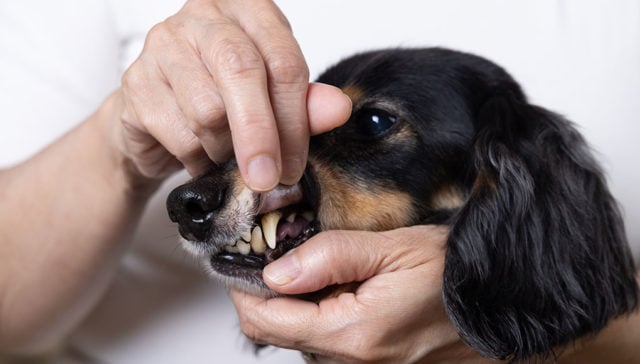
Table of Contents
Dogs have different complexions on their skin and their other body parts as well. Some are normal and others may mean something else.
What does it mean to have black gums in dogs?
Generally, a dog's gums are pink except for certain dog breeds like the Chow Chow or a Chinese Shar-pei, which are known to be bluish or black tongues with black and spotted gums.
So if you've ever noticed that your dog has black gums all of a sudden, scroll down below as we discuss possible reasons for this circumstance.
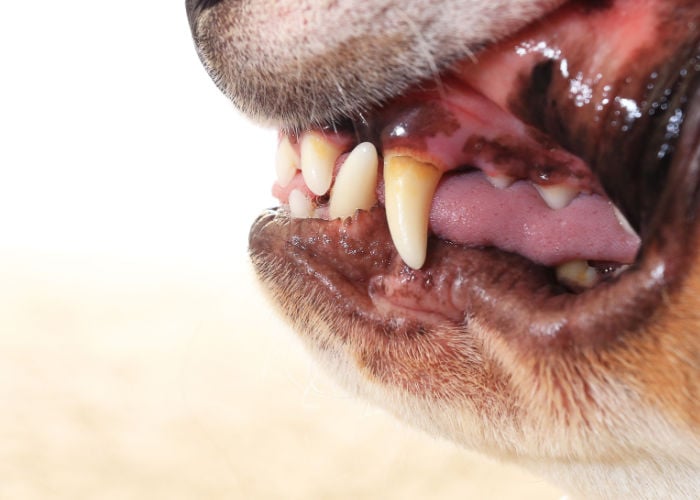
What are Black Gums in Dogs?
Often gums are left unnoticed unless there are remarkable changes such as hyperpigmentation or prominent marks of infections or disease.
If you notice the dog’s gums are darker or have turned black, it does not automatically mean they have a disease.
Sometimes black gums in dogs may be a genetic component. Some breeds have naturally dark-pigmented complexions or marks on their body. That, of course, includes the gums.
Unfortunately, black gums may also be a symptom of other underlying conditions. In this article, we’ll be discussing the possible causes of black gums in dogs.
Symptoms of Black Gums in Dogs
Symptoms for black gums may vary for each cause. But in most cases, there are dark patches of muscles or the whole gums are dark or black. Some causes may include other symptoms such as a foul smell .
Causes of Black Gums
Black gums in dogs may be a natural phenomenon or trauma or disease-induced occurrence.
Not all black gums may mean the same but here are common causes of black gums in dogs:
Aging
Aging is one of the most common causes of black gums in dogs. Naturally, as dogs age, their health also declines.
As the gums darken, there are cases where it can be accompanied or followed by a certain disease that will affect their dental health.
If owners notice the changes in their dog’s gums as they grow older, they should have their dog’s health up to par.
Since the dog’s over health is affected, veterinarians may suggest changes in diet and frequent dental care.
Note, some dog breeds are more prone to age-dental issues than other breeds.
Acanthosis Nigricans
Acanthosis Nigricans is the discoloration of the skin in dogs. It may change from a darker pigment to a black pigment.
It is a rare skin disease in dogs in dogs that may be malignant or benign. Acanthosis Nigricans can also be a symptom of other underlying diseases in dogs.
Acanthosis Nigricans affects the skin overall but can be found mostly in skin folds or areas that are affected by friction. This condition also affects the gums.
Cyanosis (Poor Oxygenation)
Cyanosis is the lack of oxygen circulating in the body. This is caused by insufficient oxygen carried by the red blood cells throughout the body.
This condition often is a symptom of dogs with circulatory or respiratory conditions.
Cyanosis can often be suspected when dogs examined have bluish-to-blackish color in their gums.
Lentigo
Lentigo is a cosmetic change in the skin of a dog or cat. The condition appears as small, patches or in full, dark, or black on the skin.
This condition does not require any treatment as it is not malignant. This condition may often be confused with other conditions that may have similar symptoms.
It’s still best to have the dog checked regularly or as soon as new black spots have appeared on the skin.
Oral Melanoma
Oral Melanoma is the aggressive production of melanocytes in the oral region. This is a type of oral cancer found in dogs and one of the most common types of cancer in dogs.
This may appear to be a black-pigmented region in the skin and be accompanied by a red swelling mass as well.
Often dogs with Oral Melanoma has pungent breath, swelling and itchy mouth, excessive drooling, bloody saliva, and even loose teeth.
Owners who suspect Oral Melanoma in their dogs must immediately have their dog checked as soon as possible.
Gingivitis-Periodontal Disease
Gingivitis is the accumulation of bacteria due to cavity buildup in cavities.
It causes inflammation that can make the gums sensitive and change the gums. Gingivitis makes the gum lining thin and red or black.
When Gingivitis is left untreated it may turn into Periodontal Disease.
This condition may heavily affect the oral and overall health of the dog if delayed and left untreated.
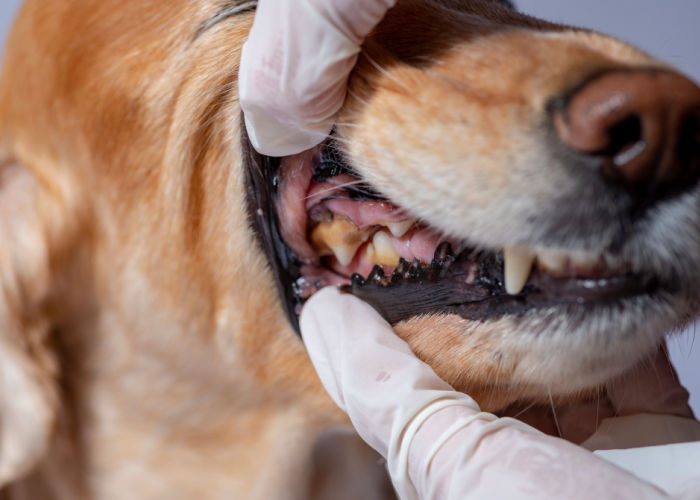
Diagnosis of Black Gums in Dogs
Black gums in dogs may mean any of the above. The proper way to determine their condition is by inquiring a professional.
The veterinarian may suggest and perform the following regarding the dog’s suspected condition:
Biopsy
For dogs with black gums that are swelling or larger than normal, a biopsy may be done after a physical examination and blood test.
This can help determine if the mass is benign or malignant. The biopsy will also determine the proper approach for the condition’s recovery.
CBC/ Blood Test Examination
A complete Blood Count can help determine a dog’s overall health much more profoundly. Aside from the physical examination and other diagnostics, CBC can help determine the dog’s condition.
Food Trial
Some dogs may just have a bad allergic reaction to a certain food that may have affected heavily on their gums.
The veterinarian may determine which food should be avoided by narrowing down the food the dog has intake and testing their effects on the dog.
Physical Examination
Physical examination may be the first diagnosis and examination done by the veterinarian.
The veterinarian may determine if the black gum area, lining, or patches may need other follow-up examinations for further inspection of the gum’s condition.
Skin Scrapings
For dogs with black gums, skin scraping may be necessary to determine if the mass is benign, malignant, or infected cells.
Urinalysis
Moreover, urinalysis may also be performed if the veterinarian suspects cases like oral melanoma.
Urinalysis can detect substances that pronounce cancer cells present in the body. Along with urinalysis, the veterinarian may still perform other diagnostics.
X-ray
In some cases, veterinarians who suspect cardiovascular, circulatory, or respiratory-affiliated disease will likely undergo an x-ray.
This can help determine if there is a complication in the organs such as fluid in the lungs.
This is likely to happen with dogs diagnosed with Cyanosis.
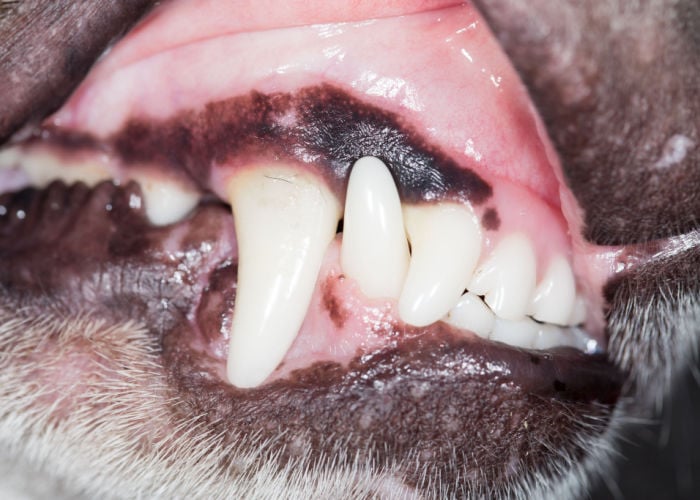
Treatment of Black Gums in Dogs
Furthermore, treatment for Black Gums in dogs may be based on its causes.
For the treatment, it’s best to follow as scheduled and as advised.
To ensure a good prognosis and prevention of other future complications, treatment should be done properly and punctually.
Here are some treatment methods the dog may receive:
Dental Hygiene Routine
For cases like Ageing and Gingivitis, dental hygiene routine should be recommended by the veterinarian.
Scheduled dental care is given and should be strictly followed for a good prognosis.
It may include brushing the teeth with dog toothpaste or a medicated one as prescribed. It may also be accompanied by flossing as needed.
Changes in Diet
On the other hand, changes in diet can also be a treatment in milder cases.
The veterinarian may suggest a varied diet that will go along with the dental care they have provided.
Some restrictions in food may also be stated but no worries as owners may ask the veterinarian may ask alternatives if the dog is used to a certain type of diet.
Oral/ Injected Medication
In some cases, veterinarians may suggest medication for treatment. This is likely prescribed for the whole duration when the symptom is present.
The prescription will more likely change depending on the medication’s response to the dog’s condition.
Professional Dental Care
There are severe cases of dogs with black gums that may go through Professional Dental Care. Cases like Periodontal Disease will likely undergo Professional Dental Care.
They may undergo general anesthesia while professionals remove build-up tartar, plaque, and cavity. This treatment will likely be redone after months as prescribed.
Surgery
Furthermore, wide surgical operations may be done for cases like Oral Melanoma in dogs. Removing the affected area is essential for improvement and a good prognosis.
Although some cases do reoccur, follow-up check-ups and following medication administration are a must to ensure a responsive treatment.
Therapy
Depending on the case, some dogs may undergo therapy as suggested.
Some may undergo oxygen therapy, radiation therapy, chemotherapy, or immunotherapy, whichever the veterinarian deems is best for the dog’s recovery.
The dog may undergo weeks in session and may even combine two different therapy, regarding the cause.
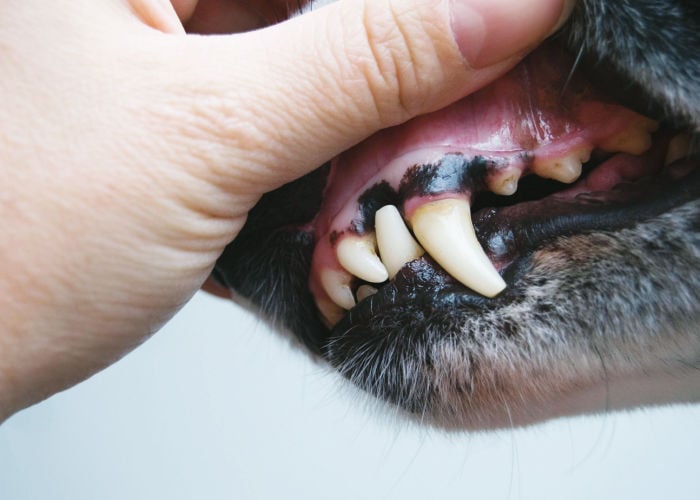
Black Gums in Dogs: Frequently Asked Questions
What do healthy gums look like?
Determining healthy gums for dogs may be difficult but self-examining them may help.
Healthy gums for dogs are usually shrimp-colored pink, and moist, with little to no plaque or tartar buildup seen.
It does not have a pungent smell, it does not swell, and it does not have large lesions and pus.
Of course, some dogs have more pigmented gums than other dogs.
If owners suspect an illness related to the black gums, it’s best to have the dog checked immediately.
Why are my dog's gums dark brown?
Dark brown gums may mean their gums are heavily pigmented. Although it does not immediately mean it has a disease or infection.
If other symptoms persist such as excessive drooling, itching, bleeding, swelling, zealous pain, pungent smell, undue tartar and plaque buildup, weakness, and other symptoms, they should have the dog checked immediately.
Are pale gums bad in dogs?
Yes, pale gums in dogs may mean the dog is undergoing internal anemia, bleeding, blood clotting, dehydration, heart disease, and shock.
Dogs who have pale gums must be checked immediately.
Black Gums in Dogs: Summary
If owners observe their dogs have black gums, they should thoroughly observe if any other unusual symptoms are occurring other than the color of the gums.
If the black patches or region grows or spreads even more, this can be a sign of other diseases.
Gums may be left unnoticed but having a dental care routine can help manage oral health.
Owners can keep a tab on their dog’s gum health by self-examining and inquiring their veterinarians about it.












